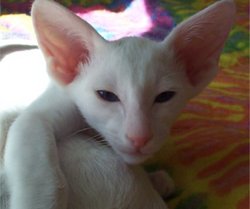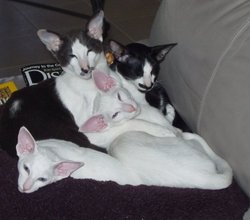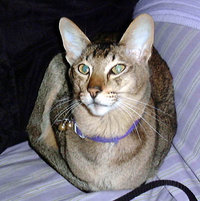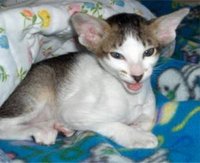

Custom Search
|
| Oriental Shorthair |
|---|

An Oriental Shorthair Blue Eyed White - Notice how
the line of the nose, eyes, and middle of the ear
form a triangular wedge.
|
| Country of origin |
| United States |
| Alternative Names |
| Foreign Type |
| Breed standards (external links) |
|
ACFA,
ACF,CFA,
TICA, GCCF, CCA, FIFe |
The Oriental Shorthair is a breed of cat. It is also called a Foreign Type cat. This cat combines the Siamese body with a diversity of colorings and patterns.
 A pile of Orientals - Two white, one blue and white bicolor, and one ebony and
white bicolor.
A pile of Orientals - Two white, one blue and white bicolor, and one ebony and
white bicolor.
Oriental Shorthairs can be found in solid colors (white, red, cream, ebony, blue, chestnut, lavender, cinnamon, or fawn), smoke (silver undercoat to any of the above except white), shaded (only the hair tips colored), parti-color (red or cream splashes on any of the above), tabby (striped) and bi-colored. In total, there are over 300 color and pattern combinations possible. In addition to the colors accepted for competition, in CFA, a pointed cat from at least one Oriental Shorthair parent is considered an AOV (Any Other Variety). In TICA, these cats are considered Siamese and can compete as Siamese.
 An Oriental Shorthair ebony-ticked tabby
An Oriental Shorthair ebony-ticked tabby
Oriental Shorthairs have expressive, almond-shaped eyes, a wedge-shaped head with large ears that fit in the wedge of the head. Their bodies are very elegant yet muscular. When seeing an Oriental Shorthair, one would never guess them to be as solid as they are.
The longhaired version of the Oriental Shorthair, Oriental Longhair, simply carries a pair of the recessive long hair gene.
 A Tabby and White Bicolor OSH
A Tabby and White Bicolor OSH
The Oriental Shorthair breed was created by crossing a Siamese to an American Shorthair. This cross was then bred back to the Siamese to retain the fine boning and elegant form.
The breed officially began around 1950 in England, when Baroness von Ullman (Roofspringer Cattery), decided to create a breed of cats with shorthair, solid colors, and the foreign body type--the long, lean body characteristic of the Siamese, Russian Blue, and Abyssinian. Initially accepted by Cat Fancy in England as chestnut foreign shorthairs , additional breeders soon created an all white, blue-eyed variant who gained popularity and recognition by Cat Fancy as white foreign shorthairs . Breeders then began cross-breeding with Siamese to move the body type closer to the Siamese.
In 1972 Peter and Vicky Markstein (Petmark Cattery) visited England looking for new Siamese breeds. Struck by the combination of colors and patterns with Siamese body-type, the Marksteins brought the breed to the United States. Shortly thereafter the Marksteins proposed that CFA recognize the breed as a separate one from the Siamese, designating it the Oriental Shorthair. CFA recognized the breed for championship status in 1977. A rapid proliferation of breedings led to new color and pattern combinations. CFA recognized the Oriental Longhair in 1995 (known as the Javanese or Havana Browns in Europe; also known as the Angora in Great Britain, but distinguished from the Turkish Angora).
 An Oriental Shorthair curious about a bag of cat food
An Oriental Shorthair curious about a bag of cat food
Oriental Shorthairs are intelligent, social animals who bond closely to their people. They are inquisitive, highly friendly, emotional, and sometimes quite vocal. People have commented that the Oriental Shorthair looks like a Greyhound or a Chihuahua. Many comment that they are much more 'dog-like' in personality.
Cats, made by MultiMedia | Free content and software
This guide is licensed under the GNU Free Documentation License. It uses material from the Wikipedia.